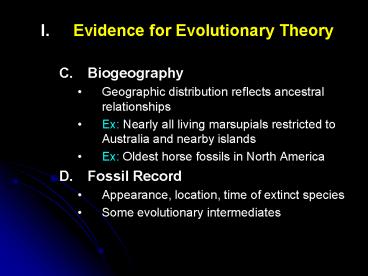Evidence for Evolutionary Theory PowerPoint PPT Presentation
Title: Evidence for Evolutionary Theory
1
- Evidence for Evolutionary Theory
- Biogeography
- Geographic distribution reflects ancestral
relationships - Ex Nearly all living marsupials restricted to
Australia and nearby islands - Ex Oldest horse fossils in North America
- Fossil Record
- Appearance, location, time of extinct species
- Some evolutionary intermediates
2
Fig. 22.16
3
Fig. 22.20
4
- Evidence for Evolutionary Theory
- Fossil Record
- Biases
- Not all organisms fossilized equally (jellyfish
vs. fish) - Fossil-bearing rocks typically form from fine
sediments (species away from fine sediments
preserved less frequently) - Tropical rain forest species decompose rapidly
before fossilizing - Fossil record biased toward organisms with hard
parts living in aquatic or arid terrestrial
environments
5
- Chromosomes
- Composed of DNA Proteins
- When cell not dividing, DNA in chromatin (long,
thin strands 2 m per human cell) - Chromosomes condense during cell division
- Humans 23 pairs with 30-70,000 genes
- Other species 2 (roundworm) -1000 (fern)
chromosomes
Fig. 12.4
Fig. 12.5
6
- Cell Cycle
- Growth ? Stop or Divide
- One cycle generation time
- Typically 8-20 hrs
- Some cells never/rarely divide at maturity
(nerve, muscle, erythrocytes) - M Phase (Mitotic Phase)
- Cell division
- Shortest part of cell cycle (10)
- Mitosis Division of nucleus (karyokinesis)
- Cytokinesis Division of cell
- Interphase
- Growth and replication of chromosomes
- G1 (Gap) Phase Growth phase (longest, most
variable) - S Phase DNA synthesis (chromosome replication)
- G2 (Gap) Phase Growth phase (synthesis of
proteins, other molecules)
Fig. 12.6
7
Fig. 12.6
8
- Mitosis
- Unique to eukaryotes
- Reliable 1 error per 100,000 cell divisions
- Continuous process divided into five stages
- G2 of Interphase
- Prophase
- Prometaphase
- Metaphase
- Anaphase
- Telophase
- Cytokinesis
9
Fig. 12.7
10
Fig. 12.7
11
- Mitosis
- Mitotic Spindle
- Composed of microtubules (polymers of tubulin)
- Microtubules are polar
- growing () end
- non-growing () end
- Moves centrosomes to opposite poles of cell
- Tugs chromosomes through cytoplasm
- Orients chromosomes along metaphase plate
- Elongates cell during anaphase
- Separates sister chromatids pulls them to
opposite poles of cell - How do the MTs do all this?
12
Anaphase
Fig. 12.8
Fig. 12.9
13
- Mitosis
- Cytokinesis
- Cell division following telophase
- Different in animal cells (no cell walls) vs.
plant cells (cell walls)
14
(Actin)
Fig. 12.10
15
Mitosis in Plant Cells
Fig. 12.11
16
- Mitosis
- Binary Fission
- Occurs in bacteria
- Does not involve mitosis
- No mitotic spindle
- Single circular chromosome
17
Fig. 12.12
18
- Mitosis
- Evolution of Mitosis
- Presumably, binary fission arose before mitosis
- Some proteins involved in binary fission are
related to eukaryotic proteins (tubulin, actin)
19
Fig. 12.13

